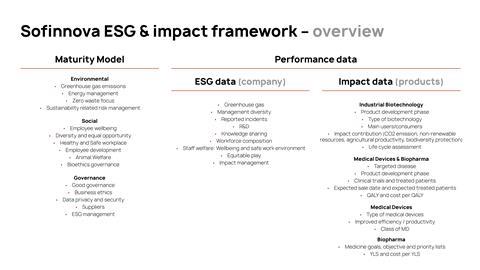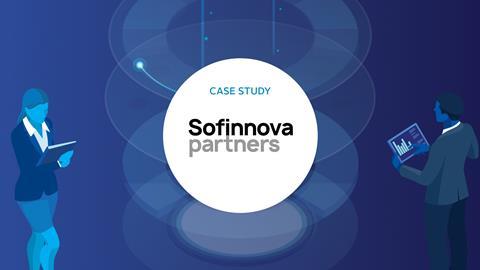Signatory type: Investment manager
Region of operation: Europe
Assets under management: €2.5bn
Sofinnova Partners is a European venture capital firm in life sciences, specialising in healthcare and sustainability. Based in Paris, London and Milan, our team is comprised of professionals from all over the world with strong scientific, medical and business expertise.
Why we take an ESG approach
Investing in new medicines, medical devices and new sustainable technologies in the food, agriculture, chemicals and materials sectors is inherently impactful. However, driving improvement with intention is how real progress is achieved – this is what we want to foster in our portfolios.
Investors are increasingly conscious of corporate social responsibility when it comes to deploying capital. In our experience, responsible and sustainable investing leads to lower risks and better returns.
More efficient operations, a better aligned and motivated workforce, a broader and more diverse talent pool, stronger governance and increased sensitivity to regulatory and compliance topics all yield positive (financial) results.
We recognise that as investment managers, we can strongly influence the value of portfolio companies through our ESG strategy.
For decades, “Improving patients’ lives through science” has been our mission. In 2020, we started evolving our ESG and impact approach across our portfolio of 70+ companies. We are a data-driven firm and understand the need to invest in relationships, in the communities we serve and in the future.
As such, moving towards a more hands-on, active ESG and impact-focused approach that can help us maximise growth at each step of a portfolio company’s evolution has been a natural next step.
Our ESG approach
Historically we conducted annual ESG surveys of our companies, collecting, analysing and reporting data without having a structured approach to driving change.
We recognised that our portfolio required a new approach due to its growing heterogeneity – in terms of company stages and sectors.
We decided to assess the ESG maturity of our companies to provide guidance on relevant, applicable goals and suitable ESG activities at each phase of their development.
We needed consistent, relevant KPIs to consolidate into meaningful analysis and recognised that not all popular ESG metrics are appropriate for early-stage companies. For example, questions about gender pay-gap, diversity or environmental footprint management are less relevant for a three-person company than for one preparing to be listed, whereas safety in the workplace is a critical measurement at all company stages.
We developed a set of material ESG themes for our Maturity Model (see Figure 1), with specific KPIs, graded across five stages of ESG maturity (from no ESG activity to gold standard). We use the same themes and indicators for all portfolio companies, but expect different scores per growth phase, demonstrating a maturity of ESG development. We complement these qualitative KPIs by collecting quantitative performance data.
Our approach resonates with company CEOs as it demonstrates empathy for the challenges they face, including providing ESG data, and offers a roadmap with realistic expectations that they can follow, including a benchmark of their ESG maturity.
For example, under Healthy and safe workplace, a low-scoring company (Level 0) doesn’t have any policies that are focused on establishing a safe (good working conditions, including absence of discrimination and harassment) and healthy (low sick leave, health promoting activities) workplace that is free of harassment and discrimination.
A company will have a mid-stage score (Level 2) when it can demonstrate that it collects data on workplace health and safety annually and establishes internal mechanisms to report safety incidents. It would reach the gold standard (Level 4) when 100% of employees are satisfied with workplace health and safety (including sexual harassment, discrimination and workplace bullying).
Figure 1: Sofinnova ESG and impact framework

To align our objectives with our investment teams, we created a Responsible Investment Oversight Committee comprising senior leaders, including investment partners representing each fund strategy.
This group ensures our ESG policy and process are implemented consistently in each portfolio company, that teams are updated on best practises and that knowledge is disseminated broadly through our firm and portfolio.
Due diligence and investment decision making
We use a detailed exclusion policy and a dedicated ESG section in our due diligence process to assess each potential investment. No decisions can be made until an ESG due diligence discussion has occurred, in the same way that commercial and scientific discussions are a prerequisite.
We have fund-specific investment committees where discussions, ideas and plans are turned into actions, should an investment decision be reached.
Where we opt to make an investment, we undertake a raft of ESG-related procedures and activities, including a 100-day and three-year roadmap (connected to our due diligence findings), sharing best practises, such as incident reporting, with the portfolio company and preparing the management team to participate in our annual CEO survey.
This survey, conducted each calendar year, forms the baseline entry into our maturity model, with any near/mid-term actions having been identified, developed and documented during the due diligence process.
Each time a company has completed the CEO survey, we assess their development opportunities, with the goal of helping them graduate through our maturity model.
We achieve this by following a series of clearly defined steps, shared with each portfolio company. It is these activities and progress that we communicate in our LP ESG reporting and, ultimately, our ESG journey report, which will be incorporated into the sales documentation when we seek an exit.
Examples
Governance example: Identifying and rectifying cybersecurity issues at a mid-stage company
A company in our mid-stage portfolio was having cybersecurity issues and we identified them as being at risk from phishing due to some unusual email activity, with a clear potential for fraud to occur.
As a result of our conversation with the company and with the support of IT professionals, they put tighter controls in place, including multiple approval steps before data or funds can be transferred, enhanced IT security, two-step authentication and training for all staff on the risks of phishing.
We then shared the best practises applied in this case across our portfolio, raising our investees’ awareness of the risks and solutions identified.
Enhancing the governance structure of our portfolio companies is a key method of de-risking their future growth and ensuring they are focused on risk mitigation. We make our internal expertise available to our portfolio companies to provide insight, advice, including guidance on how to minimise IT risks and in the event of an issue, to help them recover.
Social and governance example: Enhancing the make-up and knowledge of a late-stage company board
We found that the board of one of our late-stage portfolio companies did not possess the right levels of skill and experience to support the firm. It also lacked diversity.
We identified this during our due diligence of the potential investment. We clearly communicated to the management team our opinion and once we negotiated and executed the investment in the company, we started building the board to match its needs. In doing so, we attracted three highly experienced female board members.
Today, the eight-person board has a 50:50 gender ratio and brings to the firm the depth and breadth of experience and perspective required to support the management team.
As a company develops and matures, we aim to help them manage transition. For example, by taking an early-stage team and adding experience; or updating a board’s knowledge of areas that are less relevant when it is focused on the research and development of its products – such as commercialisation. We do so by making use of our own diverse networks.












